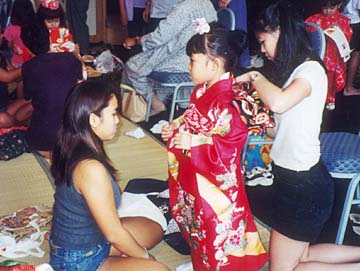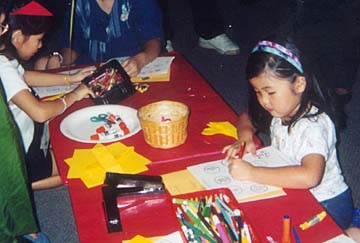


|
Sugar and spice and everything nice." The Japanese version of that saying would be something like "pure and sweet and fresh as spring" if Hina Matsuri, better known in Hawaii as Girls' Day, is any indication. Dolls highlight salute to girls
By Joleen Oshiro
joshiro@starbulletin.comThe festival, held each year on March 3, should indeed reflect the Japanese attitude toward little misses, since it's a centuries-old tradition. Hina Matsuri takes its roots from an ancient Shinto spring-welcoming ritual and celebrates daughters using symbolism from that season of renewal, said Betsy Young, a volunteer at the Japanese Cultural Center of Hawaii, which is holding its own Girls' Day festival on Sunday.
Special foods served on Hina Matsuri, for example, include hishimochi, a diamond-shape mochi with green, white and red layers. "The green layer represents the freshness of spring and fertility; the white, winter and purity; and the red, the color of spring flowers," Young said. Other foods traditionally served are clam soups with spring herbs, which represent purity and recognize the new season, and a sweet, mild sake, symbolizing longevity and happiness, that even the girls could partake of.
When: 11 a.m. to 2 p.m. Sunday HINA MATSURI
Where: Japanese Cultural Center of Hawaii, 2454 S. Beretania St.
Cost: Free, except for kimono dressing and lunches
Call: 945-7633
Hina Matsuri is also referred to as "peach festival" ("momo no sekku"). "After all, the peach was a symbol of softness, mildness, peacefulness, happiness and marriage," Young said.
But what most reflects the celebration itself is "hina ningyo," the doll display (indeed, "Hina Matsuri" translates to "doll festival") that will be housed in the JCCH ground-floor community gallery.
In its most elaborate form, the hina ningyo is a full seven tiers, topped by dolls of a Heian Period (794-1192) emperor and empress. The next tier houses three ladies-in-waiting, followed by five musicians, two government workers and footmen. The bottom tier displays items of daily life such as carriages, dressers, plates and peach trees.
Traditionally, a newborn girl received a doll display from her maternal grandparents in time for her first Hina Matsuri. But not all girls celebrated their first festival with a complete display (which is no small investment).
Helen Takeuchi, director of community relations at the Japanese Cultural Center, remembers her childhood in Japan. "My family wasn't wealthy, so I started out with the two pieces (of the emperor and empress). Every year, my family added a piece to the set. Anticipating the addition each year was meant to cultivate in girls patience, respect, diligence and responsibility," Takeuchi said.
The hina ningyo was put on display about two weeks before Hina Matsuri, then taken down on that day. Beliefs held that leaving the display up beyond March 3 would cause the girl to marry late.
On the surface it may seem strange that a culture noted for being so male-centered is also one of the few that honors its daughters each year. Yet with all its symbolism of womanly virtues -- purity, fertility, mildness, softness, patience, respect, desire for marriage -- Hina Matsuri has clearly reinforced Japan's traditional gender roles for many a century.
Time marches on, however, and it seems that Girls' Day is at long last becoming more about the girl and less about the peachy softness she should possess.
Yukashi Smith, a graduate student at the University of Hawaii who grew up in Japan, said that today the celebration mostly provides comfort to parents hoping daughters will grow up healthy and have happy marriages.
Here in Hawaii, Takeuchi said that she jokes with other JCCH staffers about how tradition dictates the doll display be taken down by March 3, while the center is leaving its Girls' Day exhibit up until March 9.
"We joke that we're encouraging girls who maybe don't want to marry, who want to do other things."
That's a fresh spin on tradition.

|
Check out the festivities at the Japanese Cultural Center. Events include a shamisen recital, minyo dancing, Japanese dance lesson, keiki arts and crafts and kimono dressing. For fees, girls are invited to be dressed up by professional kimono dressers and have their pictures taken. Girls who own their own kimono are encouraged to wear it to the festival and take part in a parade. The cultural center's gallery, which houses the hina ningyo, will be open. Furusato restaurant has created a limited number of gourmet boxed lunches for the festival using spring foods in pink, white and green, that will be available for a fee while supplies last. Here are some of the activities being featured:
5th Floor Main Stage in Manoa Grand Ballroom
11 a.m. -- Kilauea Minbu Kai Japanese minyo dancing
11:40 a.m. -- Japanese songs presented by children from Urata Music Studio
12:10 p.m. -- Japanese Women's Chorus
1 p.m. -- Japanese dance lesson by Kilauea Minbu Kai dancers
1:30 p.m. -- Shamisen recital by Atsuko Nonaka, Sawako Sumida and Chisato Yata
5th Floor Diamond Head Ballroom
Kimono dressing/photo op packages available in 15-minute intervals from 10:30 a.m. to 2 p.m. Reservations are required by calling 945-7633, although a few walk-ins will be accepted.Packages range from trying on a kimono for $5, to a full kimono dressing, makeup, hair and 4-by-6 photo package which is $75.
5th Floor Ewa Ballroom
Keiki arts and crafts activities include Hina Matsuri crafts by local artist and Japanese-language teacher Nobuko Izumi. Make your own origami Hina Ningyo (Girls' Day emperor and empress dolls) and other paper crafts; book markers; paper baskets; try on nail polish and decals; and view displays of Girls' Day artwork by students from Makakilo's Mauka Lani Elementary and Hongwanji Mission School.Kumihimo, the Japanese art of cord braiding, will also be demonstrated by Carol Nagano. Traditionally, kumihimo was used to create obijime, the cord that ties the obi sash to the kimono. With the popularity of Western clothing, however, kumihimo has transitioned into accessories such as necklaces and bracelets.
Visitors will be able to try their hand at a simple kumihimo jewelry design and take home their creation.
5th Floor Lanai Area
Vendors will be selling Japanese gifts, Girls' Day manju, T-shirts, jewelry, rubber stamps and Japanese fabrics.
Later this year at JCCH
>> Genealogy Workshop, March 16
>> Generation Kikaida Festival, April 12
>> Boys' Day Festival, May 5
>> Tanabata Festival, July 7
>> Kokusai sake Kai Sake Festival, Sept. 22-27
>> "Kikizake Sake" Sake Tasting Event, Sept. 25
>> New Year Festival 2003, Jan. 12
Click for online
calendars and events.